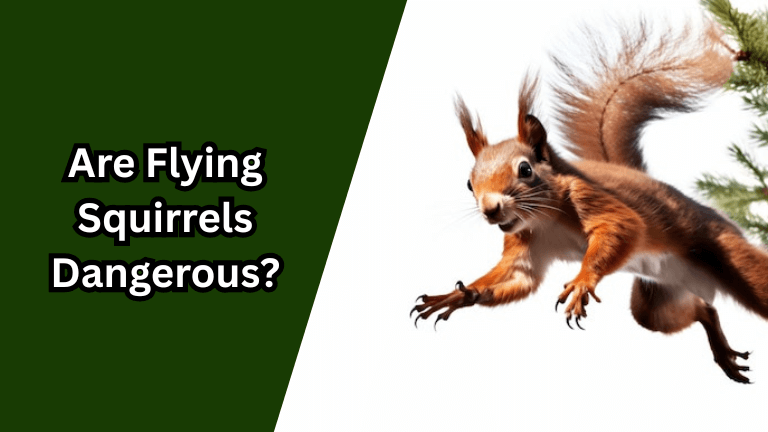Flying squirrels are small, nocturnal gliders that capture curiosity with their unique movement and gentle appearance. But how safe is it to have one nearby — or even in your home? This article gives you the clearest, most accurate information backed by expert research.
Flying squirrels are not considered dangerous to humans. They are shy, nocturnal animals that avoid contact. However, they may carry parasites or diseases and can damage property when nesting indoors.
This article dives deeper into their behavior, health risks, and what to do if one ends up in your attic or living space.
Are Flying Squirrels a Threat to Humans?

Flying squirrels do not pose a direct threat to humans. Unlike red squirrels, which may show territorial aggression, flying squirrels are timid and nocturnal. Their primary instinct is to flee rather than fight. They rarely bite unless cornered or handled improperly.
Most risks come from indirect interactions. For instance:
- Bites: Very rare, but possible when the animal feels trapped.
- Allergies: Some people may have allergic reactions to their droppings or fur.
- Zoonotic diseases: Though uncommon, flying squirrels can carry Rickettsia prowazekii, the bacterium that causes epidemic typhus.
In general, flying squirrels are considered low-risk and are not aggressive toward humans or pets.
Potential Property Damage From Flying Squirrels
While not physically dangerous, flying squirrels can cause significant damage if they enter attics, walls, or crawl spaces. In search of warmth or nesting areas, they may:
- Chew electrical wires (posing a fire hazard)
- Tear insulation
- Leave droppings and urine in ceilings or attic floors
- Create strong, unpleasant odors over time
Their presence is usually detected by the sound of scampering at night.
Signs of infestation include:
- Nocturnal noises in the attic
- Insulation shredded or shifted
- Droppings that resemble grains of rice
Are Flying Squirrels Dangerous to Pets?
Flying squirrels are not aggressive toward household pets like cats or dogs. In fact, they are more likely to be injured by pets than to attack them. However, interactions should be avoided.
The bigger concern is disease transmission. Parasites such as fleas or mites may transfer to your pets, especially if the squirrel has made a nest in the attic or garage.
Can Flying Squirrels Carry Diseases?
Yes, but the risk is relatively low. One notable concern is epidemic typhus, which can be transmitted by body lice or fleas from flying squirrels, though this is extremely rare and generally occurs only in isolated cases in the U.S.
Other risks include:
- Leptospirosis
- Salmonella
- Roundworms
According to the Centers for Disease Control and Prevention (CDC), healthy people with brief or indirect exposure are at very low risk. However, those cleaning up squirrel nests or droppings should wear gloves and masks.
What to Do If a Flying Squirrel Gets Indoors
If you encounter a flying squirrel inside your home:
- Do not attempt to catch it by hand. This increases the risk of bites or injury to the animal.
- Close off other rooms to contain it.
- Open windows or doors if possible to allow it to exit.
- Contact a wildlife control expert if it does not leave on its own.
Note: Flying squirrels are protected in some states, and it may be illegal to trap or relocate them without a permit.
Are Flying Squirrels Kept as Pets Safe?
In some regions, flying squirrels are kept as exotic pets. Southern flying squirrels (Glaucomys volans) are the most common species in the pet trade. They are generally not dangerous but require specialized care, socialization, and housing.
Key points to consider:
- They are nocturnal, so they’re active at night.
- They require bonding time and may become depressed without it.
- Improper care can lead to behavioral issues or poor health.
Important: In many U.S. states and countries, it is illegal to keep wild flying squirrels without a permit. Always check local wildlife regulations before considering one as a pet.
1. Do flying squirrels bite humans?
Bites are very rare and typically only occur if the animal feels threatened or is improperly handled.
2. Are flying squirrels aggressive like red squirrels?
No. Flying squirrels are not aggressive and tend to avoid confrontation altogether.
3. Can flying squirrels damage your house?
Yes, especially if nesting in attics. They can chew wires and damage insulation.
4. Is it safe to keep a flying squirrel as a pet?
Only in regions where it’s legal, and only if you understand their nocturnal nature and care needs.
5. What diseases can flying squirrels carry?
In rare cases, they can carry parasites and zoonotic diseases like typhus or leptospirosis.
Conclusion
Flying squirrels are not dangerous in the traditional sense — they are non-aggressive, shy, and mostly keep to themselves. However, they can cause problems if they invade homes or interact too closely with pets or people. Knowing how to safely respond, especially when they enter human spaces, is key to avoiding unnecessary risk.
